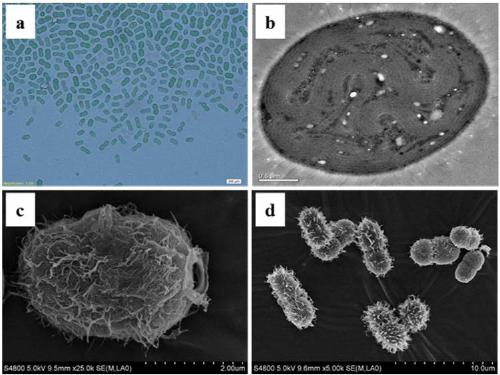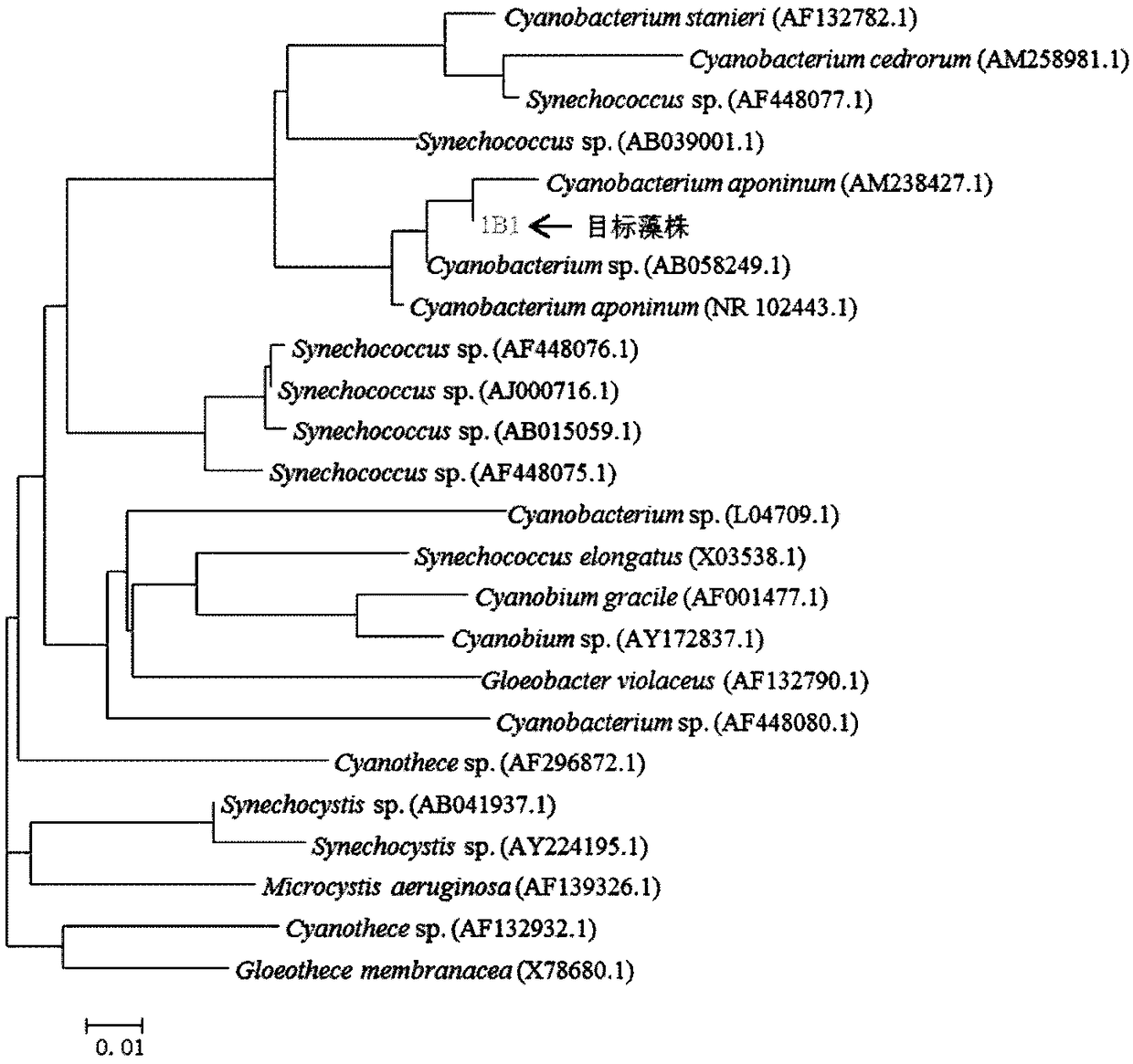Cyanobacteria strain capable of being used for glycosylglycerol production and application thereof
A technology of glucoside and cyanobacteria, which is applied in the direction of microorganism-based methods, bacteria, microorganisms, etc., can solve the problems of field environment tolerance and scale cultivation technology limitations of industrial application production cost strains, and achieve strong environmental adaptability, The effect of strong synthetic ability
- Summary
- Abstract
- Description
- Claims
- Application Information
AI Technical Summary
Problems solved by technology
Method used
Image
Examples
Embodiment 1
[0026] Example 1: Morphological identification of algal strains
[0027] 1. Optical microscope observation method
[0028] 1) Turn on the power of the optical microscope (BX51, olympus, Japan), and adjust the condenser to the appropriate brightness of the field of view.
[0029] 2) Will grow to OD 730 =1.0 (about 4 days of culture) took 1 drop of the algae solution, dropped it on a clean glass slide, and covered it with a cover glass.
[0030] 3) First find the cells of the algae strain under the 40 times objective lens, then drop 1 drop of cedar oil on the cover glass, observe the cell morphology of the algae strain under the 100 times objective lens, and take microscopic photos of the cells (see figure 1 ).
[0031] 2. SEM sample preparation method
[0032]1) Sampling: take 15mL1B1 algae liquid (OD 730 =1.0-1.5) centrifuge at 4000rpm for 1min, remove the supernatant, add 1mL of PBS phosphate buffered saline (8g L -1 NaCl, 0.24gL -1 K H 2 PO 4 , 0.2g L -1 KCl, 1.44...
Embodiment 2
[0051] Embodiment 2: Algae strain species identification based on 16S ribosomal DNA sequence
[0052] 1. Amplification and sequencing of 16S ribosomal rDNA sequence of 1B1 strain
[0053] Take 1mL 1B1 algae cell culture (OD 730 =1.0), the cells were collected by centrifugation; resuspended in 20 μL of sterile water, and repeatedly frozen and thawed in liquid nitrogen and 65° C. for 6 times. Centrifuge at 8000 rpm for 1 minute. 1.5 μL of the supernatant was used as a template for the PCR reaction, and the 16S rDNA fragment was amplified by PCR using sgF / sgR as the primer pair (the components and procedures of the PCR reaction are shown in Tables 1 and 2, respectively). The obtained PCR fragments were directly sent to the sequencing company for determination, and the DNA sequences shown in Sequence Table 1 were obtained.
[0054] Table 1 PCR reaction system
[0055]
[0056] Table 2 PCR reaction program
[0057]
[0058] Primers used in Table 3
[0059]
[0060] 2...
Embodiment 3
[0079] Example 3: Evaluation of the salt tolerance, growth rate, and synthetic ability of compatible substances of 1B1 algae strain
[0080] 1. Evaluation of the salt tolerance of algal strains
[0081] Inoculate 1B1 strain and Synechocystis PCC6803 strain into BG11 medium containing 0mM, 300mM, 600mM and 900mM sodium chloride, respectively, at 30°C, 30μE / m 2 / s light intensity, cultivated on a shaker at 150rpm for one week, and observed the growth of algal strains. The composition of BG11 medium is 1.5g L -1 NaNO 3 ,40mgL -1 K 2 HPO 4 ·3H 2 O, 36 mg L -1 CaCl 2 2H 2 O, 6 mg L -1 Citric acid, 6mg L -1 Ammonium ferric citrate, 1mg L -1 EDTA disodium salt, 20mg L -1 NaCO 3 ,2.9mg L -1 h 3 BO 3 ,1.8mgL - 1 MnCl 2 4H 2 O, 0.22 mg L -1 ZnSO 4 ·7H 2 O, 0.39 mg L -1 NaMoO 4 2H 2 O, 0.079 mg L -1 CuSO 4 ·5H 2 O and 0.01 mg L -1 CoCl 2 ·6H 2 O.
[0082] 2. Evaluation of growth rate of algal strains
[0083] Insert 1B1 strain and Synechocystis PCC6803 ...
PUM
 Login to View More
Login to View More Abstract
Description
Claims
Application Information
 Login to View More
Login to View More - R&D
- Intellectual Property
- Life Sciences
- Materials
- Tech Scout
- Unparalleled Data Quality
- Higher Quality Content
- 60% Fewer Hallucinations
Browse by: Latest US Patents, China's latest patents, Technical Efficacy Thesaurus, Application Domain, Technology Topic, Popular Technical Reports.
© 2025 PatSnap. All rights reserved.Legal|Privacy policy|Modern Slavery Act Transparency Statement|Sitemap|About US| Contact US: help@patsnap.com



